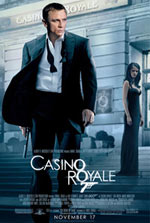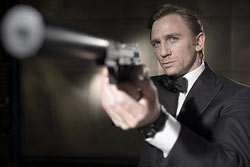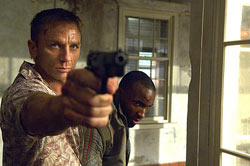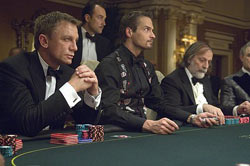
Casino Royale

 – for intense sequences of violent action, a scene of torture, sexual content and nudity.
– for intense sequences of violent action, a scene of torture, sexual content and nudity.
Director: Martin Campbell
Starring: Daniel Craig, Eva Green, Judi Dench
Running Time: 2 hours, 24 minutes
Theatrical Release Date: November 17th, 2006

Plot Summary
Casino Royale, the 21st James Bond adventure in the most successful franchise in film history, stars Daniel Craig in his debut as 007 and is based on Ian Fleming’s first novel to feature the ultimate secret agent, which was published in 1953. Casino Royale traces the early career of James Bond. His first “007” mission leads him to Le Chiffre (Mads Mikkelsen), banker to the world’s terrorists. In order to stop him and bring down the terrorist network, Bond must beat Le Chiffre in a high-stakes poker game at Casino Royale. Bond is initially annoyed when a beautiful Treasury official, Vesper Lynd (Eva Green), is assigned to deliver his stake for the game and watch over the government’s money. But as Bond and Vesper survive a series of lethal attacks by Le Chiffre and his henchmen, a mutual attraction develops, leading them both into further danger and events that will shape Bond’s life forever… (from MovieWeb.com)
Film Review
It was slightly over a decade ago now that director Martin Campbell resuscitated the dying franchise of James Bond by inserting Irish-born actor Pierce Brosnan into the key role. Campbell went on to make two Zorro features, as well as a couple other films in between, before slipping into his directorial Bond shoes once again. A serious revisiting of the 1967 comedic version of Ian Fleming’s book Casino Royale once again relaunches the series with a yet another new Bond, British actor Daniel Craig, the series’ very first blue-eyed, blond-haired super spy.
The Bond character has come great distances since its inception with Sean Connery as the leading man. In recent years, Brosnan has been the very face of James Bond, defining the character for my generation. However, as the humor-tinted spy thrillers with Connery gave way to considerably different successors, and eventually to the more campy, flashy, gadget-intensive quartet of Brosnan films, the franchise seemed to have lost its way. While those films were often decent popcorn flicks, Bond wasn’t taken quite as seriously anymore. Enter Daniel Craig. With more recent successful “serious” action films like The Bourne Identity series hitting big screens, it doesn’t surprise me that the wallets behind the Bond franchise would rethink their methods. And completely starting over with a new James Bond, starting out at his first mission, seems to be a good plan — even going back to the director who last rebooted the film series. So with twenty films in the James Bond catalog, the question is, “where do we go from here?”

Casino Royale is a near perfect introduction to a new generation for 007. The film’s opening sequence, presented entirely in black and white, shows the viewer just how James receives his “double O” status, setting up the film for being his very first mission as “007.” He’s young, he’s confident (maybe a little too much), and his superior M isn’t quite sure she can trust him or if he’s even right for the job. Casino Royale shows Bond making plenty of mistakes, taking many many hits, and shedding more blood than probably all of his predecessors. It’s a much grittier Bond, and a lot less glamour for the sake of glamour. It feels like a new era for the character and it actually feels right.
As important as his name is to the series, so is the music. Composer David Arnold, who cleverly updated the score to modern times for the previous three Brosnan outings, returns to the composing seat. With the previous films, Arnold mixed a heavy amount of techno and synths to give it a very modern, very cool vibe, but this obviously doesn’t quite fit within the vision of Casino Royale. Arnold holds the classic Bond theme back for the entire film, as if to say, “well, he’s Bond, but he’s not the Bond you know him as quite yet.” In fact, it isn’t until just before the credits roll that the full-on Bond theme appears. Instead, throughout the film, hints of the classic theme drift in and out of the action, used sparingly, and used to accent that the character is on his way to being the ultimate super spy. And that about describes how the character is approached in Casino Royale altogether. Craig is easing the audience into Bond. It’s at a card table that James first discovers his signature vodka martini drink, and it’s through events that unfold in this particular plot that reveal just why James needs to learn not to trust people — and why his character becomes known for an inability to committ in a relationship (to put it politely). Arnold approaches the music more orchestrally than modernly, and it fits more appropriately for the scope of Casino Royale.
The action and plot of Casino Royale is some of the best for the series in years. James takes a beating but he also sure knows how to give one. And we see he’s not perfect, nor is he impervious to pain or bleeding. It’s violent and brutally so at times, but seldom graphic. Craig brings a no-nonsense side to Bond that Brosnan lacked, but still knows when a sarcastic comment or joke fits in a moment. When French actress Eva Green shows up about halfway through the film as Vesper Lynd, the two possess an incredible chemistry and ability to banter wonderfully, offering some of the best dialog ever found in a Bond film (at least, of the ones I’ve seen). I originally thought Daniel Craig was entirely the wrong choice for James Bond but I was gladly proven wrong upon viewing the film. Craig was a wise choice indeed.

Content is always a problem with the James Bond franchise. With each film you can expect heaps of violence, shapely women, mild language, and a sex scene or two. Casino Royale‘s only difference is the overall sexuality of the film was toned down a bit while the violence was amped. There’s quite a bit of bloodshed, particularly from Bond himself as he’s beaten, slashed, etc. A pretty serious torture scene borders on disturbing until some surprise humor is used to lighten the mood of it. The end result is wince-inducing, leaving the viewers torn in deciding whether laughing when its intended is actually appropriate or not. Sexuality is of course present, as Bond seduces a man’s wife to learn information, but leaves her before it escalates. Later we see a few brief scenes of him making out with Vesper and in bed with her, but no actual in-the-act moments are seen. Finally, there is a prolonged scene with a man sitting naked in a chair while being interrogated, but only side views are show with no explicit nudity visible. While the sexuality is sadly trademark to the Bond character, it’s unfortunate it must be included at all, as it ultimately isn’t imperative to the story and only seems to glorify the spy’s womanizing ways (although this particular story doesn’t paint Bond as a full-blown womanizer… just yet). As an action film, Casino Royale is about as good as it gets, but the action is intense, although not too graphic, as wounds and the like are often not focused upon. Still, Casino Royale is an adult film through and through. I wouldn’t mind seeing the grit toned down a bit further or the sexuality dropped altogether, but Heaven knows that would be asking a bit much from Hollywood. We’re about as likely to see that happen as to see Bond quit drinking and take up knitting as a hobby.
Overall, Casino Royale is the best Bond film in the past few decades. Daniel Craig was an inspired choice to rejuvenate a waning franchise and Casino Royale is proof. While Campbell has created a worthy action film, it does feel a bit long at times, especially when the climax feels like the film’s end before it merely gives way to a love story development following some confusing plot elements and what seems like a second climax/ending. Still, it all works together for the whole of the story in the end. In the same way the Bourne films brought some edge to the action genre, Casino Royale does the same, but that also means that there’s plenty of objectionable content in the movie to limit viewers and rule out families altogether. Even under the guide of a DVD filtering system like Clear Play, it will still be a bit rough. Still, action fans will find a lot to like here with the twenty first James Bond adventure, Casino Royale.
– John DiBiase (reviewed: 11/18/06)
Parental Guide: Content Summary
![]() Sex/Nudity: Solange shows a great deal of skin in a bikini and later a low-neck dress; Although married, Solange allows Bond to woo her and we see the two lying on the floor clothed, while she kisses down his chest (which is exposed as his shirt is open). She moves out of camera range (down his chest), but Bond begins asking her questions which eventually ends their time together when he soon leaves (it’s assumed they don’t sleep together); Valenka is seen with a criss cross-topped dress that is a bit revealing (but not explicit); A man sits nude in a chair that has its bottom cut out so the man’s genitals and but hang through (we only see a side view of his butt, but no explicit view of the genitals or crotch). The man is struck in the bottom repeatedly with a thick rope as he is interrogated (and makes a comment about the man torturing him “scratching his balls” for him, in a mocking way); Vesper comments that Bond can have her “anywhere” and Bond makes a suggestive comment about what he could do with his “little finger” (after she says something about liking his smile and little finger); We see Vesper and James passionately making out and land on a bed before accidentally rolling off onto the floor; There’s a brief shot of James and Vesper making out on a beach; James and Vesper are lying in bed together (presumably naked under the covers). She then gets up and we see her buttoning a shirt up and briefly see her shapely figure as she does so.
Sex/Nudity: Solange shows a great deal of skin in a bikini and later a low-neck dress; Although married, Solange allows Bond to woo her and we see the two lying on the floor clothed, while she kisses down his chest (which is exposed as his shirt is open). She moves out of camera range (down his chest), but Bond begins asking her questions which eventually ends their time together when he soon leaves (it’s assumed they don’t sleep together); Valenka is seen with a criss cross-topped dress that is a bit revealing (but not explicit); A man sits nude in a chair that has its bottom cut out so the man’s genitals and but hang through (we only see a side view of his butt, but no explicit view of the genitals or crotch). The man is struck in the bottom repeatedly with a thick rope as he is interrogated (and makes a comment about the man torturing him “scratching his balls” for him, in a mocking way); Vesper comments that Bond can have her “anywhere” and Bond makes a suggestive comment about what he could do with his “little finger” (after she says something about liking his smile and little finger); We see Vesper and James passionately making out and land on a bed before accidentally rolling off onto the floor; There’s a brief shot of James and Vesper making out on a beach; James and Vesper are lying in bed together (presumably naked under the covers). She then gets up and we see her buttoning a shirt up and briefly see her shapely figure as she does so.
![]() Vulgarity/Language: 1 “Chr-st,” 3 “d*mn,” 7 “h*ll,” 2 “a” words, 2 “G-d”
Vulgarity/Language: 1 “Chr-st,” 3 “d*mn,” 7 “h*ll,” 2 “a” words, 2 “G-d”
![]() Alcohol/Drugs: Many people drink throughout the film; Bond drinks quite a bit, and has several of his classic “vodka martini’s” (as do others)
Alcohol/Drugs: Many people drink throughout the film; Bond drinks quite a bit, and has several of his classic “vodka martini’s” (as do others)
![]() Blood/Gore: We see Bond try to drown a man in a sink; Bond chases a man who appears to have heavy scarring on his skin; Le Chiffre has a severe scar on his eyelid and occasionally throughout the film we see a drop of blood appear from his tear duct; While fighting, Bond and the man he’s chasing have some blood on their faces/heads; There’s a brief shot of a photo with a man with a bloody bullet hole on their forehead; At a museum exhibit for the human body, there are various skeletons and mannequins with varying degrees of skeletal muscle tissue on them (some appear rather gross); Bond has some bloody scrapes on his face after a fight; Although not bloody or gory, we briefly see a dead woman tangled in a hammock with sand on her face, and we learn she had been tortured before murdered; Bond has a tiny bruise/bit of blood on his arm after a tracking device is injected into his forearm; During a brutal fight in a stairwell, Bond has a lot of blood on his face and shirt as he’s cut with a machete and from fighting with a few men. We then see him after the fight as he tries to clean himself up; A man makes himself vomit to try to dispell some poison they’ve been given; Bond is a little bloody after a rolling and wrecking his car; A man takes a knife to Bond’s skin to pick out the tracking device under his skin and we see an out-of-focus shot of this; A man’s face falls within the foreground of a camera shot and we briefly see a bloody bullet wound on the dead man’s forehead (just a dot of bloody, not a graphic wound); Bond shoots a nail gun at a man who wears glasses with one black eye patch. We then see a big nail sticking out of the part of the glasses with the eye patch (not gory, but a bit unsettling); We see a person struggling underwater as they drown
Blood/Gore: We see Bond try to drown a man in a sink; Bond chases a man who appears to have heavy scarring on his skin; Le Chiffre has a severe scar on his eyelid and occasionally throughout the film we see a drop of blood appear from his tear duct; While fighting, Bond and the man he’s chasing have some blood on their faces/heads; There’s a brief shot of a photo with a man with a bloody bullet hole on their forehead; At a museum exhibit for the human body, there are various skeletons and mannequins with varying degrees of skeletal muscle tissue on them (some appear rather gross); Bond has some bloody scrapes on his face after a fight; Although not bloody or gory, we briefly see a dead woman tangled in a hammock with sand on her face, and we learn she had been tortured before murdered; Bond has a tiny bruise/bit of blood on his arm after a tracking device is injected into his forearm; During a brutal fight in a stairwell, Bond has a lot of blood on his face and shirt as he’s cut with a machete and from fighting with a few men. We then see him after the fight as he tries to clean himself up; A man makes himself vomit to try to dispell some poison they’ve been given; Bond is a little bloody after a rolling and wrecking his car; A man takes a knife to Bond’s skin to pick out the tracking device under his skin and we see an out-of-focus shot of this; A man’s face falls within the foreground of a camera shot and we briefly see a bloody bullet wound on the dead man’s forehead (just a dot of bloody, not a graphic wound); Bond shoots a nail gun at a man who wears glasses with one black eye patch. We then see a big nail sticking out of the part of the glasses with the eye patch (not gory, but a bit unsettling); We see a person struggling underwater as they drown
![]() Violence: Lots of action violence (especially mentioned above under Blood/Gore), including some explosions, many people shot and killed; a man motions to cut off a woman’s arm with a machete, but does not; A bad guy finds that a bomb was attached to him and we hear the explosion, but do not see it; We suddenly hear a gunshot and see that a man has been shot in the leg, which throws them to the ground. They then crawl up to a man holding a machine gun who presumably will kill them (or interrogate them), but we do not see it; and many other acts of action violence…
Violence: Lots of action violence (especially mentioned above under Blood/Gore), including some explosions, many people shot and killed; a man motions to cut off a woman’s arm with a machete, but does not; A bad guy finds that a bomb was attached to him and we hear the explosion, but do not see it; We suddenly hear a gunshot and see that a man has been shot in the leg, which throws them to the ground. They then crawl up to a man holding a machine gun who presumably will kill them (or interrogate them), but we do not see it; and many other acts of action violence…
